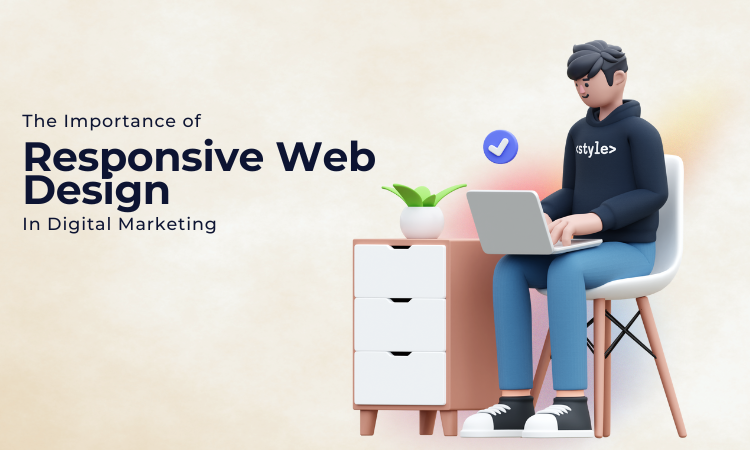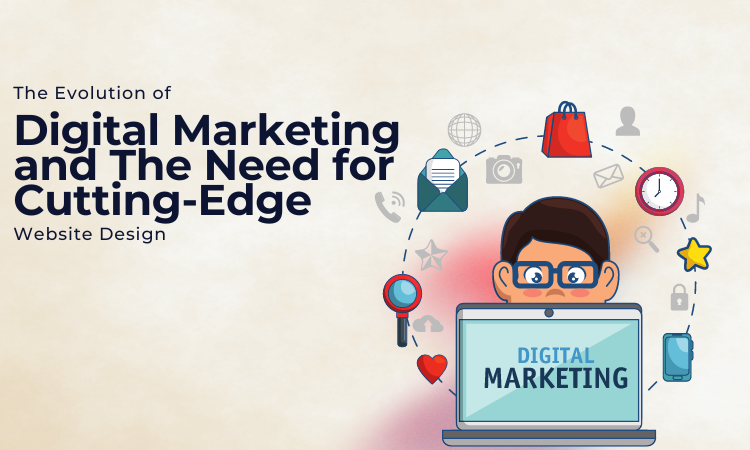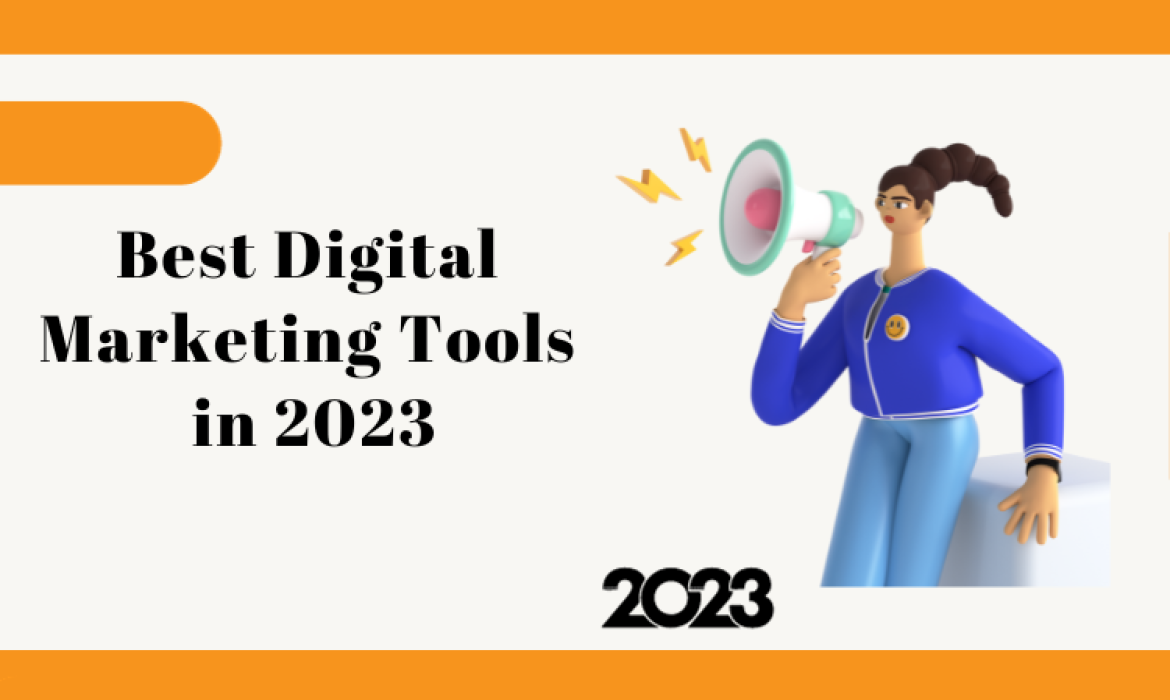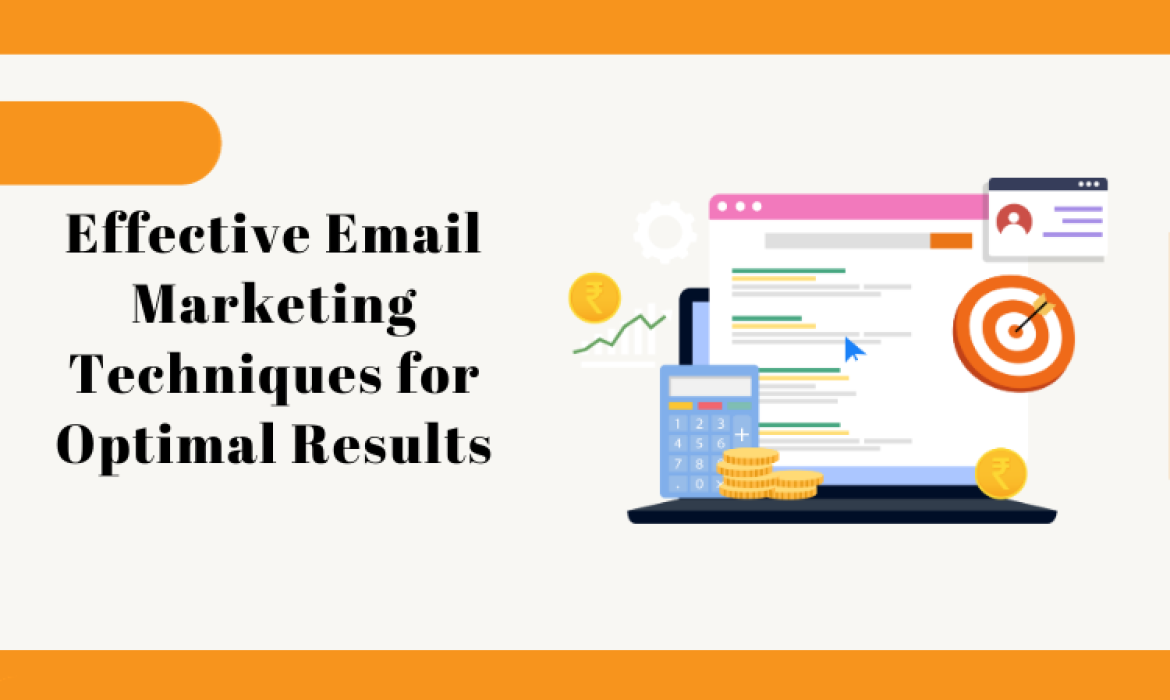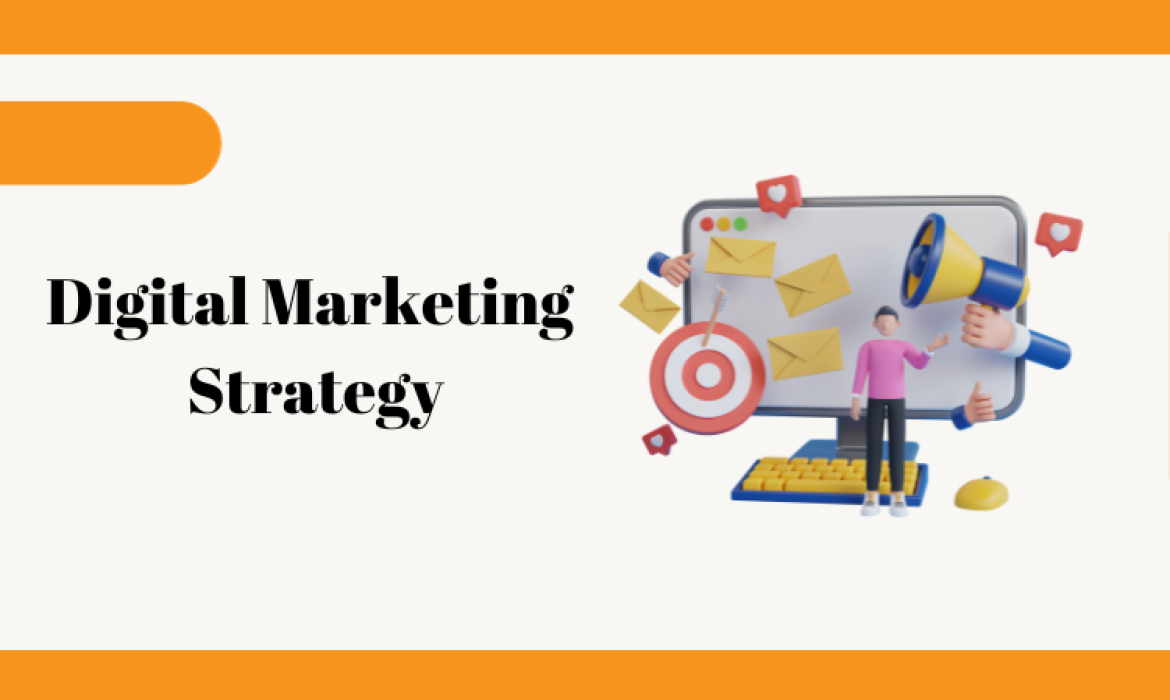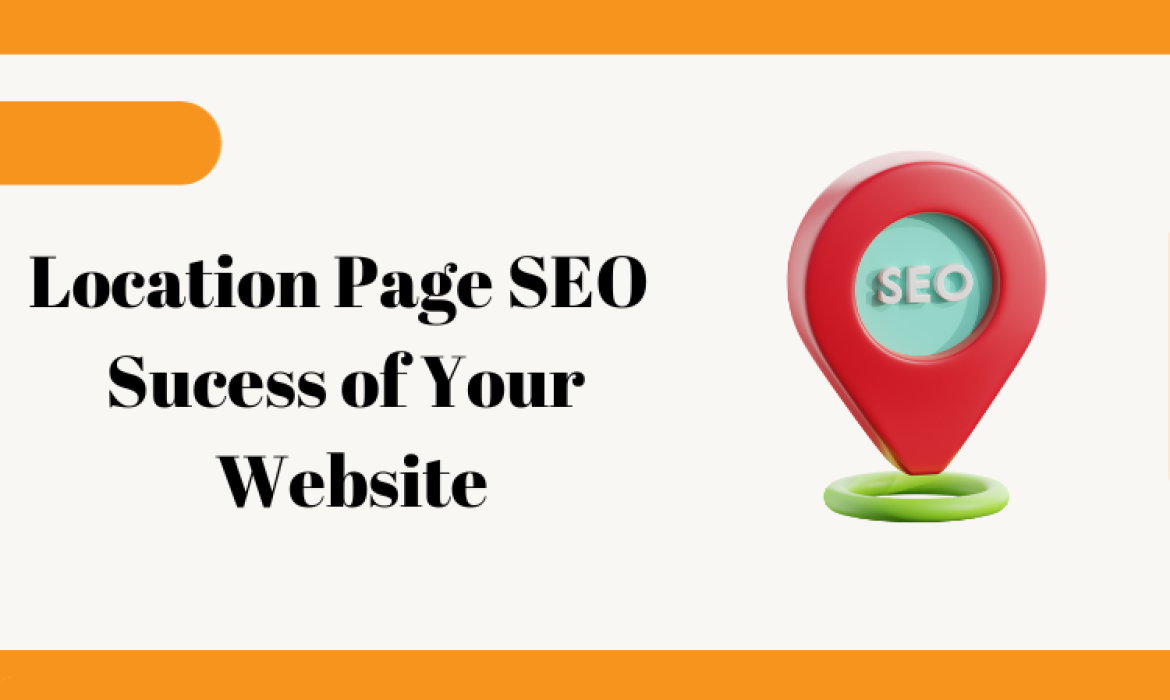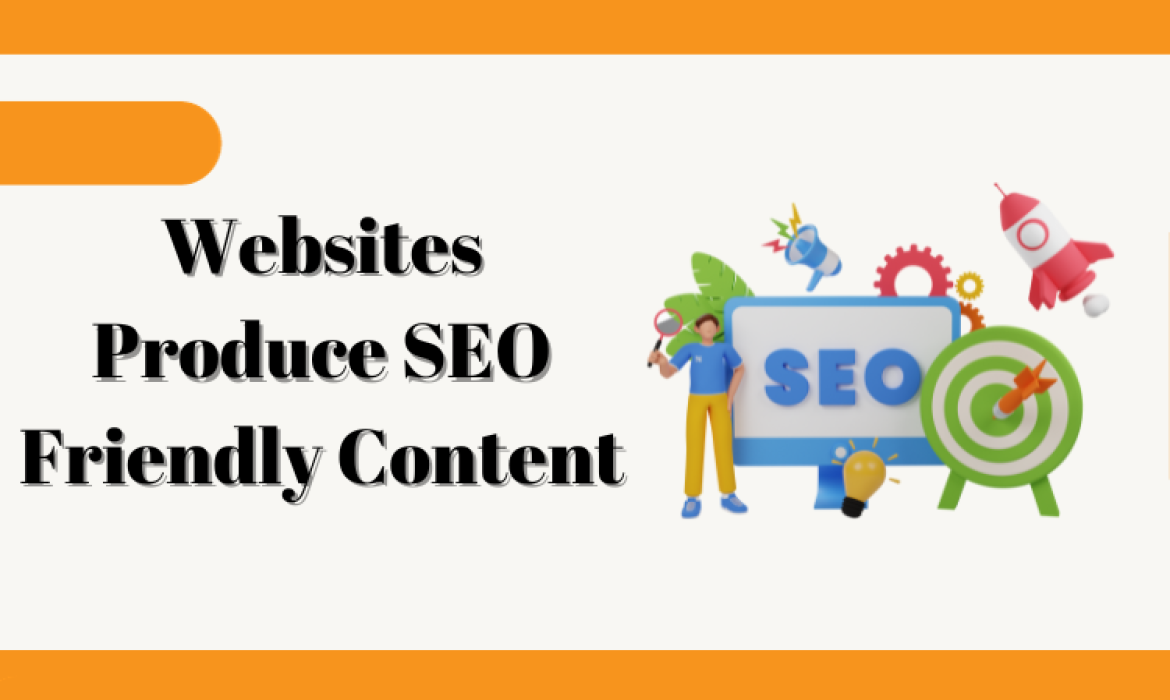The Ultimate Guide to Digital Marketing Tools in 2023
Navigating the Digital Landscape: An Overview of the Top Digital Marketing Tools
In the fast-paced world of digital marketing, success often hinges on having the right tools at your disposal. This comprehensive guide serves as your compass through the digital landscape, offering an overview of the top digital marketing tools in 2023 and providing insights into their categories, specializations, and the evolving trends shaping the tool market.
Understanding the Digital Marketing Tool Landscape: Categories and Specializations
Before diving into specific tools, it’s essential to understand the broader landscape. Digital marketing tools can be categorized into various specializations, each serving a unique purpose. This section provides a foundational understanding of these categories, setting the stage for a deeper exploration of specialized tools.
The Evolution of Digital Marketing: Trends Shaping the Tool Market in 2023
Digital marketing is a dynamic field, constantly evolving to meet new challenges and opportunities. Explore the trends shaping the tool market in 2023, from the increasing role of artificial intelligence to the emphasis on user-generated content. Understanding these trends is crucial for making informed decisions in tool selection.
Search Engine Optimization (SEO): Tools to Boost Your Online Visibility
SEO remains a critical aspect of digital marketing, influencing online visibility and organic traffic. Delve into the essential tools that can enhance your SEO efforts, from keyword research tools to on-page optimization platforms. Stay ahead of the competition by incorporating these tools into your strategy.
Social Media Management: Navigating the Social Sphere with Cutting-Edge Tools
Social media has become a cornerstone of digital marketing. Explore cutting-edge tools that streamline social media management, allowing you to schedule posts, analyze performance, and engage with your audience effectively. These tools are designed to simplify the complex landscape of multiple social platforms.
Email Marketing Automation: Streamlining Communication for Maximum Impact
Email marketing remains a powerful tool for direct communication with your audience. Discover the latest email marketing automation tools that can streamline your campaigns, personalize communication, and maximize the impact of your messages. Automation ensures efficiency without compromising personalization.
Analytics and Data Visualization: Unleashing the Power of Insights
In the data-driven era, analytics and data visualization tools are indispensable. Uncover the tools that transform raw data into actionable insights, helping you make informed decisions and refine your marketing strategies. Visualization enhances the accessibility and understanding of complex data sets.
Content Marketing Tools: Crafting Compelling Narratives for Your Audience
Compelling content lies at the heart of successful digital marketing. Explore tools that aid in content creation, distribution, and performance measurement. From ideation to execution, these tools are designed to help you craft narratives that resonate with your target audience.
Top Picks for 2023: A Comprehensive Review of Leading Digital Marketing Tools
All-in-One Solutions: Platforms that Streamline Your Digital Marketing Efforts
Efficiency is paramount in digital marketing. This section reviews all-in-one solutions that integrate multiple functionalities into a unified platform. Discover platforms that streamline your digital marketing efforts, allowing for seamless collaboration and centralized control.
Emerging Players: Rising Stars in the Digital Marketing Tool Landscape
Innovation often comes from emerging players in the market. Explore the rising stars in the digital marketing tool landscape, showcasing tools that bring fresh perspectives and functionalities to the table. These tools may present unique features that could redefine your approach to digital marketing.
User-Friendly and Cost-Effective: Tools for Small Businesses and Startups
Not every business has an extensive budget for digital marketing tools. Discover user-friendly and cost-effective tools tailored for small businesses and startups. These tools prove that effective digital marketing is accessible to all, regardless of the size of your marketing budget.
Maximizing Effectiveness: Pro Tips for Leveraging Digital Marketing Tools
In the dynamic landscape of digital marketing, staying ahead requires more than just having the right tools; it also requires knowing how to leverage them effectively. This article explores pro tips for maximizing the effectiveness of digital marketing tools, covering topics such as integration into your marketing strategy, best practices for implementation and optimization, and insights into overcoming common challenges. Additionally, we’ll delve into the future of digital marketing tools, exploring trends and predictions, including the transformative forces of artificial intelligence and machine learning, privacy and compliance considerations, and the rise of user-generated content tools.
Integrating Tools into Your Marketing Strategy: A Step-by-Step Guide
Successful integration of digital marketing tools into your overall strategy is crucial for achieving desired results. Here’s a step-by-step guide to help you seamlessly incorporate these tools into your marketing efforts:
Assessment of Business Goals: Begin by aligning your tool selection with your business objectives. Identify key performance indicators (KPIs) and goals that the tools should contribute to achieving.
Tool Selection: Choose tools that align with your identified goals. Consider factors such as scalability, compatibility with existing systems, and ease of integration.
Team Training: Ensure that your team is well-versed in using the selected tools. Training programs can bridge knowledge gaps and empower your team to use the tools effectively.
DataData Integration: Establish a cohesive data flow between your selected tools. Seamless integration ensures that data is shared efficiently across different platforms.
Workflow Optimization: Streamline workflows by mapping out how tasks and processes will be handled using the tools. This helps in avoiding redundancies and ensuring efficiency.
Continuous Evaluation: Regularly assess the performance of integrated tools. Identify areas of improvement, track KPIs, and be ready to make adjustments to your strategy.
Best Practices for Tool Implementation and Optimization
Implementing digital marketing tools is not a one-time task but an ongoing process. Follow these best practices to ensure effective implementation and optimization:
Clear Objectives: Clearly define what you aim to achieve with each tool. Whether it’s increased website traffic, better engagement on social media, or higher conversion rates, having specific goals is essential.
Customization: Tailor the settings of your tools to align with your unique business needs. Customization allows you to extract maximum value from the features offered by each tool.
Regular Updates: Keep your tools up-to-date with the latest versions and patches. This ensures that you benefit from new features, improved security, and bug fixes.
Data Security: Prioritize the security of sensitive data. Implement encryption measures, secure user access, and regularly audit data access to protect against potential breaches.
Cross-Tool Compatibility: Choose tools that can work seamlessly together. Cross-tool compatibility enhances the efficiency of your marketing stack and prevents data silos.
User Feedback: Encourage feedback from team members using the tools daily. Insights from users can provide valuable information on the real-world usability and effectiveness of the tools.
Overcoming Common Challenges: Troubleshooting Your Digital Marketing Toolkit
Despite the benefits, digital marketing tools come with their fair share of challenges. Here are common challenges and strategies for troubleshooting your digital marketing toolkit:
Integration Issues: If tools are not syncing as expected, revisit integration settings, and consult tool documentation for troubleshooting tips. Sometimes, a minor adjustment can resolve integration issues.
Data Discrepancies: Discrepancies in data can occur due to various reasons. Regularly audit data sources and ensure that the settings are aligned for accurate reporting.
User Resistance: Team members might resist using new tools. Address this by highlighting the benefits, providing training, and showcasing success stories to inspire confidence in tool adoption.
Tool Overload: Having too many tools can lead to confusion and inefficiency. Regularly assess the necessity of each tool, and consider consolidation or replacement with more comprehensive solutions.
Performance Issues: Slow performance or crashes can be frustrating. Optimize your systems, ensure adequate bandwidth, and reach out to tool support for guidance if performance issues persist.
Changing Tool Landscape: Tools evolve, and sometimes this might impact their compatibility with your existing setup. Stay informed about updates and changes, and plan for adjustments accordingly.
The Future of Digital Marketing Tools: Trends and Predictions
As we look to the future, several trends are set to shape the landscape of digital marketing tools. Here’s a glimpse into what the future holds:
Artificial Intelligence and Machine Learning: Transformative Forces in Digital Marketing
Artificial intelligence (AI) and machine learning (ML) are increasingly becoming integral to digital marketing. Predictive analytics, personalized content recommendations, and chatbots are just the tip of the iceberg. Expect these transformative forces to redefine how we approach marketing strategy and decision-making.
Privacy and Compliance: Navigating the Changing Landscape
With growing concerns about privacy, tools will need to adapt to stricter regulations. Future digital marketing tools will likely prioritize user data protection, compliance with privacy laws, and transparent data practices. Marketers must be vigilant in adhering to evolving standards to maintain trust with their audiences.
The Rise of User-Generated Content Tools: Harnessing the Power of Authenticity
User-generated content (UGC) is gaining momentum, and tools that facilitate its creation and curation are on the rise. From customer reviews to social media posts, brands are increasingly leveraging UGC to build authenticity and trust. Expect tools that harness the power of authenticity to play a significant role in future marketing strategies.
Your Digital Marketing Toolkit: Adapting for Success
As you navigate the evolving landscape of digital marketing tools, remember that adaptability is key. Proactively integrate tools into your marketing strategy, follow best practices for implementation and optimization, and troubleshoot challenges as they arise. Embrace the trends shaping the future, and stay informed about the transformative forces of AI, changing privacy landscapes, and the rise of user-generated content.
In the ever-evolving world of digital marketing, success lies not only in the tools you choose but also in how effectively you leverage them to achieve your goals. Stay agile, stay informed, and empower your digital marketing journey with the right strategies and insights to unlock success in 2023 and beyond.
Your Digital Marketing Toolkit: Building a Comprehensive Arsenal for Success
Customizing Your Toolkit: Tailoring Tools to Fit Your Unique Business Needs
In the ever-expanding landscape of digital marketing, having a diverse and effective toolkit is essential for success. One size does not fit all, and customizing your toolkit to align with your unique business needs is a strategic imperative.
Understanding Your Business Goals
Before embarking on the customization journey, take a step back and clearly define your business goals. Whether you’re looking to increase brand awareness, drive website traffic, or boost sales, understanding your objectives is the foundation upon which you’ll build your customized toolkit.
Identifying Key Areas for Improvement
Conduct a thorough assessment of your current digital marketing strategy. Identify areas that need improvement or expansion. This could range from enhancing your social media presence to refining your email marketing campaigns. Pinpointing these areas guides your customization efforts toward the most impactful tools.
Selecting Tools Aligned with Your Objectives
Armed with a clear understanding of your business goals and areas for improvement, carefully choose tools that align with these objectives. Whether it’s a social media management platform, an advanced analytics tool, or content creation software, ensure that each tool serves a specific purpose in achieving your goals.
Integrating Seamlessly
Customization goes beyond individual tools; it extends to how these tools work together. Prioritize tools that seamlessly integrate. A cohesive digital marketing ecosystem minimizes friction in workflows and enhances overall efficiency.
The Role of Training and Skill Development: Maximizing the Potential of Your Team
Building a comprehensive digital marketing toolkit is only half the battle. Maximizing its potential requires a skilled and knowledgeable team. Invest in training and skill development to ensure that your team can harness the full power of your customized toolkit.
Identifying Training Needs
Evaluate the skill sets of your team members with the tools you’ve chosen. Identify any gaps or areas where additional training is required. This could involve technical training for specific tools or broader skills development in areas such as data analysis or content creation.
Providing Access to Learning Resources
Many digital marketing tools offer comprehensive learning resources, including tutorials, webinars, and documentation. Ensure that your team has access to these materials to facilitate self-paced learning. Additionally, consider investing in external training programs or workshops for more in-depth knowledge.
Encouraging Continuous Learning
The digital marketing landscape is dynamic, with tools evolving and new ones emerging regularly. Foster a culture of continuous learning within your team. Encourage them to stay updated on industry trends, explore new features in existing tools, and be proactive in seeking out opportunities for skill development.
Empowering Team Collaboration
Effective use of digital marketing tools often involves collaboration among team members. Provide opportunities for cross-functional training, allowing team members to understand how different tools fit into the overall strategy. This fosters collaboration and ensures a holistic approach to digital marketing.
Evaluating ROI: Ensuring Your Digital Marketing Tools Deliver Results
As you tailor your toolkit and invest in skill development, the ultimate measure of success lies in the return on investment (ROI). Rigorous evaluation ensures that your digital marketing tools are delivering tangible results aligned with your business objectives.
Defining Key Performance Indicators (KPIs)
Establish clear and measurable KPIs that align with your business goals. Whether it’s increased website traffic, higher conversion rates, or improved social media engagement, having defined KPIs provides a benchmark for evaluating the effectiveness of your toolkit.
Implementing Analytics and Tracking
Integrate robust analytics tools into your toolkit to track and measure performance. Analyze data regularly to gain insights into the impact of your digital marketing efforts. Tools that offer real-time reporting and customizable dashboards are particularly valuable in this regard.
Conducting Regular Audits
Periodically, conduct audits of your digital marketing toolkit. Assess the performance of individual tools, their integration, and their contribution to overall objectives. Identify any underperforming tools or areas for optimization.
Soliciting User Feedback
The individuals using the tools daily—your team members—are valuable sources of feedback. Encourage them to provide insights into the usability, efficiency, and effectiveness of each tool. This user feedback can inform decisions on tool retention, replacement, or further customization.
Conclusion
In the ever-evolving world of digital marketing, building a customized toolkit tailored to your unique business needs is a strategic imperative. As you embark on this customization journey, keep your business goals at the forefront, identify areas for improvement, and carefully select tools that align with your objectives.
Maximizing the potential of your toolkit goes hand in hand with investing in the skills of your team. Training and skill development ensure that your team can leverage the full capabilities of your chosen tools, fostering a culture of continuous learning and collaboration.
ROI is ultimately what determines the success of your digital marketing initiatives. Define clear KPIs, implement robust analytics, conduct regular audits, and solicit user feedback to ensure that your toolkit is delivering tangible and impactful results.
In conclusion, empower your digital marketing journey by taking action with the best tools in 2023. Building a comprehensive arsenal for success involves a strategic blend of customization, skill development, and continuous evaluation. As you tailor your toolkit to fit your unique business needs, you position your team for success in the dynamic and competitive landscape of digital marketing.
Unveiling the Best and Most Effective Email Marketing Techniques for Optimal Results
Crafting a Path to Success with Email Marketing Mastery
In the dynamic realm of digital marketing, email remains a powerful tool for connecting with audiences, fostering relationships, and driving business success. This comprehensive guide aims to unravel the intricacies of email marketing, providing actionable insights and strategies for marketers looking to achieve optimal results in their campaigns.
Understanding the Essence of Email Marketing
The Evolution of Email Marketing
Email marketing has come a long way since its inception. From simple text-based messages to visually appealing and interactive content, the evolution of email marketing reflects the changing landscape of digital communication. Understanding this evolution sets the stage for implementing effective strategies in the contemporary marketing landscape.
Why Email Marketing Matters in the Digital Age
Some people might be surprised to learn that email marketing is still relevant in an era where social media and instant messaging apps are prevalent. This section explores the reasons why email marketing remains a cornerstone of digital strategies, examining its unmatched reach, direct communication capabilities, and adaptability to changing consumer behaviours.
Building a Solid Foundation
Setting Clear Objectives and Goals
Success in email marketing begins with a clear understanding of the objectives and goals. Whether aiming to drive sales, build brand awareness, or nurture leads, defining these goals provides a roadmap for crafting targeted and impactful campaigns.
Creating a Targeted and Engaged Audience
Building a responsive email list is foundational to effective email marketing. This section delves into strategies for audience segmentation, list building, and methods for ensuring engagement. An engaged audience is more likely to convert, making audience development a critical aspect of success.
Crafting Compelling Content
The Art of Captivating Subject Lines
In a crowded inbox, the subject line is the gateway to capturing attention. Crafting compelling subject lines is an art that involves creativity, relevance, and a touch of psychology. Explore techniques for creating subject lines that entice recipients to open and engage with emails.
Designing Engaging and Responsive Email Templates
The visual appeal and responsiveness of email templates play a pivotal role in the user experience. This section guides marketers through best practices for designing templates that not only look good on various devices but also enhance the overall impact of the email content.
Incorporating Persuasive Call-to-Action Elements
The ultimate goal of many email campaigns is to prompt action. Learn how to create persuasive calls-to-action (CTAs) that drive desired outcomes, whether purchasing, downloading content, or signing up for an event. From placement to language, every element contributes to the effectiveness of the CTA.
Navigating the Email Marketing Landscape with Expert Techniques
Leveraging Advanced Segmentation Strategies
Personalization: Tailoring Messages for Individual Audiences
Personalization goes beyond addressing recipients by their first name. Dive into advanced personalization strategies, exploring ways to tailor content based on user preferences, behaviour, and demographic data. Discover how personalized messaging can significantly impact engagement and conversions.
Behavioural Segmentation: Understanding and Responding to User Actions
Behavioral segmentation involves analyzing how users interact with emails and responding accordingly. Uncover techniques for segmenting audiences based on user behaviour, such as opens, clicks, and purchases. Learn how to create targeted campaigns that resonate with specific segments of your audience.
Maximizing Automation for Efficiency
Implementing Effective Drip Campaigns
Drip campaigns, or automated email sequences, are a cornerstone of efficient email marketing. Explore the nuances of drip campaigns, including when and how to use them effectively. From onboarding sequences to re-engagement campaigns, discover the power of automation in nurturing leads through the customer journey.
Utilizing Triggered Emails for Timely Communication
Triggered emails are timely responses to specific user actions or events. This section explores the implementation of triggered emails, from abandoned cart reminders to post-purchase follow-ups. Discover how triggered emails enhance relevancy and contribute to a seamless customer experience.
Optimizing for Deliverability and Engagement
Best Practices for Email Deliverability
High deliverability is crucial for the success of any email marketing campaign. Uncover best practices for improving deliverability, including maintaining a clean email list, optimizing sender reputation, and adhering to industry standards. Learn how to navigate spam filters and ensure your emails reach their intended audience.
Increasing Engagement with Interactive Content
Interactive content transforms static emails into dynamic experiences. Explore the types of interactive content that resonate with audiences, from polls and quizzes to gamification elements. Discover how interactive elements not only engage recipients but also provide valuable data for refining future campaigns.
Analyzing, Refining, and Measuring Success
Harnessing the Power of Analytics
Key Metrics for Evaluating Email Campaign Performance
Analyzing campaign performance requires a nuanced understanding of key metrics. Explore metrics such as open rates, click-through rates, conversion rates, and more. Learn how to interpret these metrics to gain insights into user behaviour and campaign effectiveness.
Using A/B Testing for Continuous Improvement
A/B testing, or split testing, is a method for optimizing email campaigns by comparing variations of elements such as subject lines, content, and CTAs. Delve into the principles of A/B testing, including experimental design, execution, and interpretation of results. Discover how ongoing testing contributes to continuous improvement.
Incorporating Feedback Loops
Gathering and Analyzing Subscriber Feedback
Subscriber feedback is a valuable source of insights for refining email campaigns. Explore methods for collecting and analyzing feedback, including surveys, polls, and direct communication channels. Understand how listening to your audience can uncover areas for improvement and innovation.
Adjusting Strategies Based on Performance Insights
Data-driven decision-making is at the core of successful email marketing. This section discusses how to interpret performance insights and adjust strategies accordingly. Whether scaling successful campaigns or pivoting based on audience feedback, flexibility and adaptability are key to sustained success.
Staying Ahead with Emerging Trends and Innovations
Exploring the Future of Email Marketing
The Impact of Artificial Intelligence and Machine Learning
Artificial intelligence (AI) and machine learning (ML) are transforming the landscape of email marketing. Explore the applications of AI and ML in areas such as predictive analytics, content optimization, and personalized recommendations. Understand how these technologies enhance efficiency and effectiveness.
Interactive and Dynamic Content Trends
The future of email marketing involves pushing the boundaries of static content. Dive into emerging trends in interactive and dynamic content, including AMP for email and other innovations. Discover how these trends redefine user engagement and open new possibilities for creativity.
Adapting to Regulatory Changes
Navigating Data Privacy Regulations
In an era of heightened awareness of data privacy, marketers must navigate a landscape of regulations. This section provides guidance on adhering to data privacy regulations, including GDPR and CCPA. Learn best practices for obtaining consent, ensuring transparency, and safeguarding user data.
Building Trust through Transparent Communication
Transparency is a cornerstone of building trust with your audience. Explore strategies for transparent communication, from clear privacy policies to openly addressing user concerns. Discover how transparent practices not only comply with regulations but also foster a positive relationship with subscribers.
Mastering the Art and Science of Email Marketing
Reflecting on the Journey
Embracing Successes and Learning from Challenges
Achievements and difficulties are both part of the journey to success in email marketing. Reflect on the milestones achieved, campaigns that resonated, and lessons learned from moments of adversity. Acknowledge the dynamic nature of the digital landscape and the continuous learning inherent in mastering email marketing.
The Ever-Evolving Landscape of Email Marketing
As technology advances and consumer behaviours evolve, the landscape of email marketing continues to change. Embrace the reality that mastering email marketing is an ongoing process. Stay attuned to industry trends, innovations, and shifts in consumer preferences. Commit to continuous learning and adaptation to remain at the forefront of this dynamic discipline.
Encouraging Ongoing Mastery
Continuous Learning and Adaptation
The field of email marketing is ever-evolving, and successful marketers are those who embrace a mindset of continuous learning. Explore resources for staying updated on industry trends, attending conferences, and engaging with the vibrant email marketing community. Commit to refining skills and adopting new strategies as the digital landscape evolves.
Inspiring Creativity and Innovation in Email Marketing
Creativity is the fuel that propels successful email marketing campaigns. Encourage a culture of innovation within your team or organization. Explore ways to infuse creativity into content creation, design, and the overall campaign strategy. Remember that pushing the boundaries of what’s possible often leads to breakthroughs and memorable campaigns.
In email marketing, mastering success requires a combination of strategic planning, technical expertise, and a deep understanding of audience dynamics. By implementing the best and most effective techniques outlined in this guide, marketers can navigate the complexities of email marketing with confidence, optimize campaigns for optimal results, and cultivate lasting relationships with subscribers.
Exploring the Future of Email Marketing
In the ever-evolving landscape of digital marketing, staying ahead requires a keen eye on emerging trends and innovations. This section delves into the future of email marketing, examining how artificial intelligence (AI) and machine learning (ML) are reshaping strategies and the rise of interactive and dynamic content trends.
The Impact of Artificial Intelligence and Machine Learning
Transforming Predictive Analytics
Artificial intelligence and machine learning have revolutionized predictive analytics in email marketing. Predictive analytics enables marketers to anticipate user behaviour, preferences, and engagement patterns. Explore how AI and ML algorithms analyze vast datasets to provide insights that enhance the personalization and targeting of email campaigns.
Content Optimization with AI
AI-driven content optimization is elevating the relevance of email content. From subject lines to body copy, discover how machine learning algorithms analyze user interactions and responses to refine content recommendations. Explore case studies of successful AI-driven content optimization, revealing the power of delivering the right message to the right audience.
Interactive and Dynamic Content Trends
AMP for Email: A Game-Changer
The advent of Accelerated Mobile Pages (AMP) for email has transformed static emails into dynamic, interactive experiences. Explore the capabilities of AMP for email, from dynamic forms to real-time updates. Understand how this technology enhances user engagement and opens new possibilities for marketers seeking to captivate their audience.
Beyond Static Images: Interactive Elements
Interactive content extends beyond AMP, encompassing a range of elements that engage recipients. Dive into trends such as gamification, quizzes, and embedded video. Uncover case studies illustrating how interactive elements not only boost engagement but also provide valuable insights into user preferences.
Adapting to Regulatory Changes
Regulatory changes and data privacy concerns demand careful attention as the digital landscape matures. This section addresses how marketers can navigate regulatory changes, focusing on compliance with data privacy regulations, building trust through transparent communication, and ensuring ethical practices.
Navigating Data Privacy Regulations
GDPR and Beyond: A Global Perspective
The General Data Protection Regulation (GDPR) sets a precedent for data privacy regulations globally. Explore the implications of GDPR on email marketing practices and how marketers worldwide are adapting to similar regulations, such as the California Consumer Privacy Act (CCPA). Understand the principles of consent, data minimization, and user rights that underpin these regulations.
Building Trust through Transparent Communication
Transparency is paramount to maintaining trust with subscribers. Learn how transparent communication about data practices, privacy policies, and opt-in mechanisms strengthens the relationship between marketers and their audiences. Explore best practices for crafting clear and concise privacy statements that resonate with users.
Conclusion: Mastering the Art and Science of Email Marketing
Reflecting on the Journey
The journey through the intricate landscape of email marketing involves a continual process of learning, adapting, and embracing the dynamics of an ever-changing industry. Reflect on the successes achieved and the valuable lessons learned from the challenges encountered along the way.
Embracing Successes and Learning from Challenges
Successes in email marketing are not just markers of achievement; they are lessons in themselves. Explore case studies of campaigns that achieved remarkable results and understand the strategies that contributed to their success. Learn from the challenges faced, whether they were related to deliverability, engagement, or evolving industry trends.
The Ever-Evolving Landscape of Email Marketing
The only constant in the world of email marketing is change. Explore how the landscape of email marketing continues to evolve, from the latest technological advancements to shifts in consumer behaviours. Acknowledge the importance of adaptability and a forward-thinking approach to navigate the challenges and opportunities that lie ahead.
Encouraging Ongoing Mastery
Continuous Learning and Adaptation
Mastery in email marketing is a journey, not a destination. Encourage a culture of continuous learning within your team or organization. Explore resources for staying updated on industry trends, attending conferences, and engaging with the vibrant email marketing community. Embrace a mindset that values curiosity, exploration, and a commitment to staying at the forefront of industry advancements.
Inspiring Creativity and Innovation in Email Marketing
Creativity is the spark that fuels innovation in email marketing. Explore ways to inspire creativity within your team, from brainstorming sessions to cross-disciplinary collaboration. Case studies of innovative campaigns demonstrate the power of thinking outside the box and pushing the boundaries of what’s possible in email marketing.
In the ever-evolving landscape of email marketing, mastery is a dynamic process that combines the art of creativity with the science of analytics. By exploring emerging trends, adapting to regulatory changes, and encouraging ongoing mastery, marketers can position themselves as leaders in this dynamic field, consistently delivering optimal results and forging lasting connections with their audience.
Unlocking Strategic Success: Content Marketing Insights for Healthcare Manufacturers
In the rapidly evolving landscape of healthcare marketing, content plays a pivotal role in establishing a brand’s identity, reaching target audiences, and driving engagement. For healthcare manufacturers, understanding the nuances of content marketing is not just a necessity but a strategic imperative. This article delves into the key insights that can unlock strategic success for healthcare manufacturers, emphasizing the power of tailored content and the utilization of data-driven approaches.
The Power of Tailored Content in Healthcare Marketing
In the realm of healthcare marketing, one size does not fit all. Crafting content that resonates with the unique needs and challenges of healthcare manufacturers is essential for effective communication.
Understanding the Unique Needs of Healthcare Manufacturers
Healthcare manufacturers operate in a complex environment, dealing with regulatory requirements, technological advancements, and shifting market dynamics. This section explores the specific challenges faced by healthcare manufacturers and how tailoring content to address these challenges can enhance communication and engagement.
Crafting Compelling Narratives for Targeted Audiences
Effective storytelling is a cornerstone of successful content marketing. In the healthcare sector, where information can be technical and complex, weaving compelling narratives is crucial. This section provides insights into creating narratives that resonate with healthcare manufacturers and their diverse audiences, from healthcare professionals to end-users.
Data-Driven Approaches for Effective Content Marketing
In the age of digital marketing, data is a powerful tool that can inform and refine content strategy. This section explores how healthcare manufacturers can leverage data-driven approaches to create more impactful and targeted content.
Utilising Analytics to Inform Content Strategy
Analytics offer a wealth of information about audience behavior, preferences, and engagement. By analyzing data, healthcare manufacturers can gain valuable insights into what works and what doesn’t. This section provides practical guidance on using analytics tools to refine content strategies and optimize marketing efforts.
Measuring ROI and Refining Marketing Tactics
Understanding the return on investment (ROI) of content marketing initiatives is crucial for continuous improvement. This section discusses key performance indicators (KPIs) relevant to healthcare manufacturers and provides strategies for measuring and improving ROI.
Navigating Compliance and Ethics in Healthcare Content Marketing
Healthcare is a highly regulated industry, and content marketing must navigate a complex landscape of compliance and ethical considerations. This section addresses the importance of maintaining regulatory compliance and ethical standards in healthcare content marketing.
Ensuring Regulatory Compliance in Messaging
Healthcare manufacturers must adhere to strict regulations in their communication, and this includes content marketing. This section outlines the regulatory landscape and offers guidance on creating content that meets compliance standards without compromising effectiveness.
Building Trust through Ethical Content Practices
Trust is paramount in healthcare, and ethical content practices are essential for building and maintaining trust with stakeholders. This section explores the ethical considerations in healthcare content marketing and provides strategies for establishing credibility and trustworthiness.
Measuring ROI and Refining Marketing Tactics in Healthcare Content Marketing
In the ever-evolving realm of healthcare content marketing, the ability to measure return on investment (ROI) and refine marketing tactics is crucial for success. This article explores the intricacies of measuring ROI and the importance of navigating compliance and ethics in healthcare content marketing. Additionally, it delves into specific strategies for ensuring regulatory compliance in messaging and building trust through ethical content practices.
Navigating Compliance and Ethics in Healthcare Content Marketing
Healthcare content marketing operates within a unique framework of regulations and ethical considerations. As healthcare professionals and consumers increasingly turn to digital channels for information, it becomes imperative for marketers to navigate this complex landscape effectively.
Ensuring Regulatory Compliance in Messaging
One of the primary challenges in healthcare content marketing is ensuring that messaging aligns with regulatory requirements. This section examines the various regulations that govern healthcare communications and provides insights into crafting content that not only engages but also complies with industry standards. From the Health Insurance Portability and Accountability Act (HIPAA) to the Food and Drug Administration (FDA) guidelines, understanding and adhering to these regulations is paramount.
Measuring ROI and Refining Marketing Tactics
Demonstrating the effectiveness of content marketing initiatives is essential for securing budgets, optimizing strategies, and achieving long-term success. This section focuses on the methodologies and key performance indicators (KPIs) used to measure ROI in healthcare content marketing.
Utilizing Comprehensive Analytics
Data analytics offer a window into the performance of content marketing efforts. From website traffic and conversion rates to social media engagement and lead generation, leveraging comprehensive analytics tools is essential. This section provides insights into selecting the right metrics, interpreting data, and making informed decisions to enhance ROI.
Understanding the Lifetime Value of Content
Beyond immediate ROI, healthcare marketers need to consider the long-term impact of their content. This includes understanding the lifetime value (LTV) of content, which involves assessing how content contributes to customer loyalty, brand advocacy, and ongoing engagement. Strategies for measuring and maximizing LTV are explored in this section.
Building Trust through Ethical Content Practices
Trust is the cornerstone of successful healthcare content marketing. This section examines the importance of ethical content practices in building and maintaining trust with both healthcare professionals and consumers.
Transparency in Messaging
Transparency is a key element of ethical content practices. This involves clearly communicating information, disclosing affiliations, and being upfront about the purpose of the content. The section explores how transparency builds trust and credibility in healthcare content marketing.
Authenticity in Storytelling
Authentic storytelling resonates with audiences and establishes a genuine connection. Healthcare content marketing should prioritize authenticity to create meaningful narratives that connect with the target audience. This section provides insights into weaving authentic stories while maintaining ethical standards.
Conclusion
In conclusion, successfully navigating compliance and ethics in healthcare content marketing requires a thorough understanding of regulations, a commitment to transparency, and a focus on authenticity. Simultaneously, measuring ROI is an ongoing process that involves leveraging analytics, understanding key metrics, and assessing the long-term value of content. By integrating these elements into their strategies, healthcare marketers can not only meet regulatory requirements but also build trust, demonstrate value, and refine their tactics for sustained success in an ever-changing digital landscape.
Mastering the Art of Social Media Campaigns: Unveiling the Best Strategies and Examples
In the fast-paced world of digital marketing, the mastery of social media campaigns has become a cornerstone for brands seeking to thrive in the dynamic online landscape. Social media, with its vast reach and interactive potential, offers a canvas for creativity, connection, and strategic brand building. In this comprehensive guide, we will unravel the intricacies of social media campaigns, exploring the fundamentals of understanding the social media landscape, crafting winning strategies, and delving into best practices, all accompanied by real-world case studies that illuminate the path to success.
Understanding the Social Media Landscape
The Dynamics of Social Media Platforms
To navigate the digital terrain successfully, one must understand the unique dynamics of each social media platform. From the sprawling landscapes of Facebook to the visual allure of Instagram and the succinct messaging on Twitter, grasp the distinctions that shape user interactions on different platforms.
Importance of Social Media in Modern Marketing
The significance of social media in modern marketing cannot be overstated. Beyond just a communication tool, delve into how social media has transformed into a dynamic force shaping consumer behavior, brand perception, and marketing strategies in the contemporary landscape.
Evolving Trends in Social Media Engagement
As the digital world evolves, so do user expectations. Explore the latest trends in social media engagement, from the rise of ephemeral content to the immersive experiences offered by live streaming, and understand how brands can stay relevant amidst these ever-changing dynamics.
Crafting a Winning Social Media Campaign Strategy

Setting Clear Campaign Objectives
Every successful campaign starts with a clear vision. Learn the art of setting SMART objectives—specific, measurable, achievable, relevant, and time-bound—to guide your social media initiatives with purpose and precision.
Identifying Target Audiences and Personas
Understanding your audience is the linchpin of effective campaigns. Embark on the journey of creating detailed audience personas, enabling you to tailor your campaigns to resonate with specific demographics, interests, and behaviors.
Choosing the Right Social Media Platforms
Not all platforms are created equal. Uncover the strategic selection process behind choosing the right social media platforms based on your campaign objectives, target audience, and the nature of your content.
Crafting Compelling Campaign Messaging
Communication is an art. Explore the intricacies of crafting compelling campaign messaging that not only captures attention but also weaves seamlessly into the fabric of your brand identity.
Best Practices for Effective Social Media Campaigns
Leveraging Visual Content for Maximum Impact
In the era of visual dominance, discover the power of compelling images, videos, and infographics to capture attention and convey your brand message with maximum impact.
Utilizing Hashtags Strategically
Hashtags are more than trends; they’re strategic tools. Dive into the world of hashtags and learn how to use them strategically across different platforms to enhance the discoverability and reach of your content.
Embracing User-Generated Content
Authenticity resonates. Explore the art of leveraging user-generated content to build trust, foster community engagement, and showcase the real-world impact of your brand.
Building a Consistent Brand Presence
Consistency is the glue that binds a brand together. Understand the importance of maintaining a cohesive brand presence across platforms to enhance recognition, trust, and loyalty.
Case Studies in Social Media Excellence
Successful Brand Awareness Campaigns
Unearth case studies of brands that have successfully navigated the complex landscape of building and enhancing brand awareness through strategic and memorable social media campaigns.
Impactful Influencer Collaborations
Influencers are the digital conduits to your audience. Analyze successful collaborations and understand how influencers can extend your reach, enhance credibility, and create authentic connections with your target audience.
Viral Social Media Challenges
Decipher the magic behind viral challenges. Explore case studies that reveal the science of creating challenges that captivate audiences, drive participation, and propel your brand into the limelight.
Engaging Contests and Giveaways
Contests and giveaways are not just about prizes—they’re about engagement. Learn from brands that have effectively utilized these strategies to boost interaction, increase followers, and drive conversions.
In the following sections, we will delve into the metrics that measure the success of your social media campaigns, explore evolving trends, and discuss innovations in social media advertising.
Navigating the Social Media Landscape: From Metrics to Mastery
In the vast and dynamic world of social media marketing, success is not only about creativity and engagement but also about effective measurement, adaptation, and innovation. This comprehensive guide will delve into the intricate facets of social media campaigns, from measuring success and analyzing key metrics to staying ahead of evolving trends and fostering genuine connections within the digital community. Join us on a journey of mastery as we explore the art and science of social media marketing.
Measuring Social Media Campaign Success
Key Metrics for Performance Evaluation
Embarking on a successful social media campaign begins with understanding the metrics that matter. Dive into the essential key performance indicators (KPIs), from likes and shares to more sophisticated metrics such as conversion rates and return on investment (ROI).
Analyzing Reach, Engagement, and Conversions
Effective campaigns are built on a foundation of reach, engagement, and conversions. Explore how to analyze these crucial metrics to gain insights into your campaign’s performance and make data-driven decisions.
Utilizing Analytics Tools Effectively
In the digital age, data is power. Learn how to wield analytics tools effectively, from Google Analytics to native platform insights, to gain a comprehensive understanding of user behavior and campaign effectiveness.
Evolving Trends in Social Media Campaigns
The Rise of Short-Form Video Content
Witness the meteoric rise of short-form video content on platforms like TikTok and Instagram Reels. Explore how brands are leveraging this trend to create engaging and shareable content that resonates with today’s fast-scrolling audiences.
Incorporating Augmented Reality Experiences
Immerse your audience in your brand story through augmented reality (AR) experiences. Uncover how brands are using AR to create interactive and memorable campaigns that captivate users and elevate brand perception.
Navigating Privacy Concerns and Regulations
In an era of increasing privacy concerns, it’s crucial to navigate the landscape ethically and responsibly. Explore best practices for handling user data, complying with regulations, and building trust with your audience.
Innovations in Social Media Advertising

Targeted Ad Campaigns on Social Platforms
Precision is the key to successful advertising. Delve into the world of targeted ad campaigns on social platforms, exploring how advanced targeting options can help you reach your desired audience with precision.
Integrating E-commerce and Social Media
Witness the seamless integration of e-commerce within social media platforms. Explore how brands are leveraging features like in-app shopping to turn social media interactions into direct sales opportunities.
AI-Powered Personalization in Social Advertising
Unlock the potential of artificial intelligence in social advertising. Explore how AI-powered personalization is revolutionizing ad content, targeting, and delivery to create highly relevant and engaging campaigns.
Engaging with the Social Media Community

Responding to Comments and Messages
Community engagement is a two-way street. Explore the importance of actively responding to comments and messages, fostering a responsive and approachable brand image.
Hosting Live Q&A Sessions and Webinars
Real-time interactions create real connections. Learn how hosting live Q&A sessions and webinars can humanize your brand, provide value to your audience, and boost engagement.
Building Genuine Connections through Social Media
Authenticity is paramount. Explore strategies for building genuine connections with your audience through behind-the-scenes content, storytelling, and humanizing your brand.
Social Responsibility and Impactful Campaigns

Incorporating Social Causes in Campaigns
Beyond business objectives, social responsibility resonates with modern consumers. Explore the positive impact of incorporating social causes into your campaigns, aligning your brand with values that matter.
Addressing Social Issues Responsibly
Tackling social issues requires sensitivity and responsibility. Learn how to address social issues in your campaigns authentically, contributing to positive change without exploitation.
Promoting Sustainability and Ethical Practices
Discover how brands are leveraging social media to promote sustainability and ethical practices, resonate with environmentally conscious consumers, and contribute to a healthier planet.
Adapting to Algorithm Changes and Platform Updates
Staying Informed about Social Media Algorithms
Algorithms dictate visibility. Stay ahead by understanding the algorithms that govern social media platforms, allowing you to optimize your content for maximum reach and engagement.

Adjusting Strategies with Platform Updates
Change is constant in the digital world. Explore strategies for adapting your campaigns to platform updates, ensuring your approach remains effective and aligned with evolving features.
Capitalizing on New Features for Campaign Success
Innovation is the key to staying relevant. Discover how to capitalize on new features introduced by social media platforms, leveraging them to enhance the creativity and impact of your campaigns.
Conclusion
Recapitulation of Social Media Campaign Mastery
Summarize the key takeaways from this expansive guide, reinforcing the importance of mastering social media campaigns for sustained success.
Continuous Learning and Adaptation in the Social Media Landscape
Emphasize the dynamic nature of the social media landscape and encourage marketers to embrace continuous learning, stay abreast of trends, and adapt strategies for ongoing success.
Encouragement to Explore and Excel in Social Media Marketing
End the article by inspiring readers to explore the vast opportunities in social media marketing, emphasizing that mastery is an ongoing journey of exploration, innovation, and excellence.
By incorporating these strategies, staying informed about trends, and fostering genuine connections, businesses can not only measure the success of their social media campaigns but also stay at the forefront of the ever-evolving digital landscape.
The Latest Online Marketing Trends: Stay Ahead of the Curve
Introduction to Online Marketing Trends
In the fast-paced digital era, the landscape of online marketing is in a constant state of flux. To remain competitive, businesses must not only adapt to change but also stay ahead of the curve by embracing the latest trends. This article serves as a comprehensive guide to cutting-edge strategies that can propel your online marketing efforts to new heights.
The Dynamic Nature of the Online Marketing Landscape
The environment for online marketing is inherently dynamic due to emerging platforms, shifting consumer behaviors, and technological advancements. Understanding the fluid nature of this environment is crucial for marketers aiming to create impactful and relevant campaigns. The evolution of online marketing has been nothing short of revolutionary, from the early days of static websites to the current era of interactive content dominance.
Cutting-Edge Strategies for Online Marketing
As we delve into the latest trends, it’s evident that several strategies are reshaping the online marketing landscape, providing innovative ways for businesses to connect with their audiences.

Video Content Dominance
Video content has become a major influence in the digital era. Platforms like YouTube, TikTok, and Instagram have revolutionized how information is consumed. Marketers are leveraging the power of video to tell compelling stories, showcase products, and engage audiences on a deeper level.
Conversational Marketing with Chatbots
The rise of artificial intelligence has given birth to conversational marketing through chatbots. These automated systems provide instant and personalized interactions with users, answering queries, guiding purchasing decisions, and enhancing the overall customer experience.
Social Commerce Revolution
Social media platforms have transcended their initial purpose of connecting people; they’ve become thriving marketplaces. Social commerce, the integration of e-commerce within social platforms, is revolutionizing online shopping by providing a seamless experience from product discovery to purchase.
Personalization through AI and Machine Learning
Advancements in AI and machine learning enable marketers to personalize their strategies. From recommending products based on user behavior to tailoring email campaigns to individual preferences, personalization enhances user engagement and fosters brand loyalty.
Interactive Content Experiences
User engagement is a cornerstone of successful online marketing. Interactive content, including quizzes, polls, and live sessions, captivates audiences and encourages active participation, fostering a stronger connection between brands and consumers.
Augmented Reality (AR) and Virtual Reality (VR) Integration
The gaming industry is no longer the only sector to benefit from the immersive experiences offered by AR and VR. Marketers are incorporating these technologies to create virtual experiences, such as virtual try-ons and interactive product showcases, providing consumers with a unique and memorable brand interaction.
Navigating the Mobile-First Era
As mobile devices become integral to our daily lives, marketers must prioritize strategies that cater to a mobile-first audience.

Mobile-Optimized Websites and Apps
A seamless mobile experience is non-negotiable. Mobile-optimized websites and apps ensure that users can navigate, engage, and make purchases effortlessly on their smartphones, enhancing user satisfaction and conversion rates.
Mobile Search Optimization
Mobile search optimization is pivotal for maintaining visibility in search engine results. Marketers need to optimize content for mobile-friendly search algorithms, considering factors like voice search and local SEO for users on the go.
Mobile Advertising Innovations
Innovative mobile advertising formats, including interactive ads and native advertising, are gaining prominence. Marketers are exploring creative ways to capture the attention of mobile users without being intrusive, fostering positive user experiences.
Harnessing the Power of Social Media
Social media continues to be a dynamic force in online marketing, and understanding its evolving landscape is essential for sustained success.

Rise of New Social Media Platforms
The social media landscape is ever-expanding, with new platforms continually emerging. Marketers need to stay informed about these platforms, understand their unique demographics and features, and assess their relevance to target audiences.
Influencer Marketing Evolution
Influencer marketing has evolved beyond celebrity endorsements. Micro-influencers and nano-influencers, with their niche audiences and high engagement rates, are becoming increasingly popular for collaborations, adding authenticity to brand endorsements.
Social Listening and Community Building
Social listening tools allow marketers to monitor conversations about their brand and industry. Actively engaging in social communities fosters a sense of belonging and loyalty among followers, turning customers into brand advocates.
Data-Driven Decision Making
In the age of information, leveraging data is critical for making informed decisions in online marketing.

Big Data Analytics in Online Marketing
Big data analytics provides valuable insights into consumer behavior, preferences, and market trends. Marketers can harness these insights to refine their strategies and optimize campaigns for better results, ultimately driving business success.
Privacy Concerns and Ethical Data Usage
As data privacy concerns escalate, marketers must prioritize ethical data usage. Transparency about data collection practices builds trust with consumers and helps navigate the evolving landscape of privacy regulations.
Predictive Analytics for Targeted Campaigns
Predictive analytics empowers marketers to forecast future trends and behaviors. By leveraging predictive models, businesses can tailor their marketing efforts to target audiences more effectively, maximizing the impact of their campaigns.
In the next segment of this article, we will delve into the fascinating realm of ephemeral content, real-time marketing, and the growing importance of sustainability and ethical marketing practices. Stay tuned for an in-depth exploration of these crucial facets shaping the future of online marketing.
Embracing Ephemeral Content and Real-Time Marketing
As the digital landscape evolves, marketers are continually seeking innovative ways to capture audience attention and create meaningful connections. In this era of fleeting moments and heightened social consciousness, embracing ephemeral content and real-time marketing has become imperative. This article explores the significance of ephemeral content, strategies for real-time engagement, and the growing importance of sustainability and ethical marketing practices.

Storytelling through Ephemeral Content
Ephemeral content, characterized by its temporary nature, has become a cornerstone in the art of digital storytelling. Platforms like Snapchat, Instagram Stories, and Facebook Stories provide marketers with a unique canvas to craft narratives that disappear after a set period. This form of content delivery taps into the human psychology of urgency and curiosity, encouraging users to engage promptly.
Ephemeral content isn’t just about urgency; it’s a powerful storytelling tool. Marketers can use these short-lived moments to share behind-the-scenes glimpses, exclusive offers, and candid moments that humanize their brand. The ephemeral nature creates a sense of exclusivity, making audiences feel like insiders privy to moments that others may miss.
Real-Time Engagement Strategies
Real-time engagement is about being present in the moment and actively participating in ongoing conversations. Social media platforms, with their constant stream of updates, provide an ideal environment for real-time engagement.
Successful real-time engagement requires active monitoring of social channels, industry news, and trending topics. Brands can leverage current events, participate in trending conversations, and share timely content to stay relevant. Responding promptly to customer queries and feedback is another crucial aspect, fostering a sense of connection and responsiveness.
FOMO Marketing: Creating Urgency
Fear of Missing Out (FOMO) is a psychological trigger that marketers can strategically harness. Creating a sense of urgency through limited-time offers, exclusive deals, and flash sales taps into the innate human fear of missing out on something valuable.
FOMO marketing goes hand-in-hand with ephemeral content. By combining the temporary nature of content with time-sensitive promotions, marketers can drive immediate action and engagement. This strategy not only boosts sales but also cultivates a sense of excitement and anticipation among the audience.
Sustainability and Ethical Marketing Practices
As consumer awareness grows, there is an increasing demand for brands to align with ethical values and sustainable practices.
Eco-Friendly Marketing Initiatives
Consumers are becoming more environmentally conscious, and brands are responding with eco-friendly marketing initiatives. From sustainable packaging to eco-friendly product lines, companies are incorporating green practices into their marketing strategies. Communicating these efforts through ephemeral content can amplify their impact, showcasing a commitment to environmental responsibility.
Consumer Awareness and Ethical Branding
Consumers today are more informed than ever, and they actively seek brands that align with their ethical values. Ephemeral content provides an avenue for brands to transparently communicate their ethical practices, showcasing responsible sourcing, fair labor practices, and other initiatives that contribute to positive social impact.
Corporate Social Responsibility in Online Marketing
Corporate social responsibility (CSR) is no longer an optional add-on but a fundamental aspect of a brand’s identity. Online marketing provides a platform to highlight CSR initiatives through ephemeral content, showcasing philanthropic activities, community involvement, and other socially responsible practices.
Future Outlook and Adaptation Strategies
Looking ahead, the future of online marketing is poised for exciting developments. Adapting to technological advancements and market shifts will be key to staying relevant and competitive.
Preparing for Technological Advancements
The rapid pace of technological advancements requires marketers to be proactive in understanding and integrating new tools and platforms. Technologies like blockchain, 5G, and the Internet of Things (IoT) will undoubtedly impact the online marketing landscape. Brands that stay ahead of the curve can leverage these advancements for enhanced customer experiences and innovative marketing campaigns.
Flexibility and Agility in Adapting to Market Shifts
The digital landscape is inherently volatile, with trends and consumer behaviors evolving rapidly. Brands that exhibit flexibility and agility in adapting to market shifts position themselves for long-term success. This involves continuously monitoring industry trends, staying attuned to consumer preferences, and adjusting strategies accordingly.
Continuous Learning and Professional Development
The pursuit of knowledge is a perpetual journey in the dynamic world of online marketing. Marketers need to invest in continuous learning and professional development to stay abreast of the latest trends, tools, and best practices. Conferences, workshops, and online courses offer valuable insights and networking opportunities that can propel a marketer’s skill set to new heights.
In conclusion, the era of ephemeral content, real-time marketing, and ethical practices marks a transformative period in online marketing. By mastering the art of storytelling through ephemeral content, engaging audiences in real time, embracing sustainability, and staying adaptable to future trends, businesses can navigate the evolving digital landscape with confidence and creativity. The journey to online marketing success is not just about staying ahead but about crafting experiences that resonate and endure in the hearts of consumers.
Developing an Effective Digital Marketing Strategy: A Guide to Success
Understanding the Digital Landscape
In the ever-evolving realm of digital marketing, success hinges on a profound understanding of the landscape. This article serves as a comprehensive guide, offering insights into navigating the dynamic world of digital marketing, understanding the significance of a well-crafted strategy, and staying abreast of key trends shaping the industry today.
Navigating the Dynamic World of Digital Marketing
Digital marketing is a vast and dynamic ecosystem encompassing various channels and strategies. This section explores the intricacies of the digital landscape, providing a roadmap for businesses to navigate and capitalize on the diverse opportunities available.
Significance of a Well-Crafted Digital Marketing Strategy
A well-designed digital marketing strategy is the cornerstone of success in the online realm. This subsection delves into the importance of strategic planning, emphasizing how a thoughtfully crafted strategy can set the stage for achieving business goals and maximizing ROI.
Key Trends Shaping Digital Marketing Today
To succeed in digital marketing, staying ahead of trends is imperative. This section identifies and explores the key trends influencing the industry, from the rise of interactive content to the increasing importance of artificial intelligence in marketing strategies.
Crafting Your Digital Roadmap

With a foundational understanding of the digital landscape, the next step is crafting a roadmap that aligns with business objectives. This section provides a step-by-step guide, starting with setting goals and objectives and extending to creating detailed buyer personas and gaining a strategic edge through competitor analysis.
Setting the Foundation: Defining Goals and Objectives
Clearly stated goals and objectives are the first step in creating an effective digital marketing plan. This subsection explores the process of goal-setting, emphasizing the importance of aligning digital efforts with broader business goals for maximum impact.
Know Your Audience: Creating Detailed Buyer Personas
Understanding the target audience is paramount to crafting personalized and effective marketing messages. Here, we delve into the process of creating detailed buyer personas, enabling businesses to tailor their strategies to the specific needs and preferences of their audience.
Analyzing the Competition: Gaining a Strategic Edge
Competitor analysis is a key element of any successful strategy. This section provides insights into effective competitive analysis, helping businesses identify strengths, weaknesses, and opportunities within their industry.
Core Pillars of Digital Marketing Excellence
With a solid roadmap in place, businesses can focus on the core pillars that define digital marketing excellence. This section breaks down the essential components, from elevating visibility with SEO mastery to nurturing leads through email marketing and strategically unleashing the potential of PPC advertising.

Elevating Visibility with SEO Mastery
An essential component of digital marketing is search engine optimization, or SEO. This subsection provides an in-depth exploration of SEO strategies, covering keyword research, on-page optimization, and the latest trends shaping the SEO landscape.
Social Media Mastery: Harnessing the Power of SMM
Social media has become a powerful tool for brand promotion and audience engagement. Here, we delve into social media marketing strategies, emphasizing the importance of platform selection, content creation, and community building.
The King is Content: Acquiring Proficiency in Content Marketing
Effective digital marketing is centered around creating compelling content.
This subsection explores content marketing strategies, from creating valuable blog posts to developing engaging multimedia content that resonates with the target audience.
Direct Connections: Nurturing Leads with Email Marketing
Email marketing remains a potent tool for lead nurturing and customer retention. This section provides best practices for building and maintaining an engaged email subscriber list, crafting effective email campaigns, and measuring success.
Strategic Advertising: Unleashing the Potential of PPC
Pay-per-click (PPC) advertising offers businesses a targeted approach to reaching their audience. This subsection explores the intricacies of PPC campaigns, from keyword selection and ad copywriting to budget management and performance tracking.
Aligning Strategy with Execution
One of the most important characteristics of effective digital marketing is flexibility. This section guides businesses in integrating channels seamlessly, allocating resources effectively, and measuring success through key metrics and analytics tools.

Integrating Channels: Creating a Seamless Marketing Ecosystem
A cohesive marketing strategy requires the integration of various channels. Here, we explore strategies for creating a seamless marketing ecosystem, ensuring consistency and effectiveness across different platforms.
Budgeting for Success: Allocating Resources Effectively
Budget management is a critical aspect of digital marketing success. This subsection provides insights into allocating resources effectively, whether for advertising, content creation, or other strategic initiatives.
Measuring Success: Key Metrics and Analytics Tools
Effective measurement is essential for refining and optimizing digital marketing efforts. This section explores key performance indicators (KPIs) and the analytics tools that enable businesses to track and analyze their success.
Adapting to Change and Emerging Trends
The digital landscape is dynamic, with constant changes and emerging trends. This section emphasizes the importance of staying ahead by embracing emerging technologies, staying informed about industry trends, and adopting agile strategies to adapt to evolving platforms.
Staying Ahead: Embracing Emerging Technologies
Technological advancements continually shape the digital marketing landscape. Here, we explore emerging technologies such as artificial intelligence, augmented reality, and voice search, highlighting their potential impact on digital marketing strategies.
Riding the Wave: Keeping Abreast of Industry Trends
Staying informed about industry trends is crucial for maintaining relevance and competitiveness. This subsection provides strategies for staying abreast of trends through industry publications, conferences, and networking.
Agile Strategies: Adapting to Evolving Platforms
The ability to adapt quickly is a hallmark of successful digital marketing. This section explores the importance of agile strategies, encouraging businesses to be flexible and responsive to changes in consumer behavior, technology, and platform algorithms.
Case Studies and Best Practices
Real-world examples provide valuable insights and inspiration for developing effective digital marketing strategies. This section presents success stories, analyzes setbacks for lessons learned, and offers practical tips for implementing insights into your strategy.

Success Stories: Learning from Digital Marketing Triumphs
Case studies of successful digital marketing campaigns showcase effective strategies in action. This subsection highlights notable success stories, identifying key elements that contributed to their triumphs.
Lessons from Setbacks: Analyzing Failures for Future Success
Failure is often a stepping stone to success. Here, we explore case studies of digital marketing setbacks, analyzing the reasons behind the failures and extracting valuable lessons for future strategies.
Implementing Insights: Applying Lessons to Your Strategy
Building on the lessons learned from both successes and setbacks, this section provides actionable insights for implementing changes and improvements in your digital marketing strategy.
Aligning Strategy with Execution: Navigating the Dynamics of Digital Marketing

Aligning Strategy with Execution
In the intricate world of digital marketing, success lies not only in crafting a robust strategy but also in its seamless execution. This article delves into the crucial phase of aligning strategy with execution, exploring the intricacies of integrating channels, effective budgeting, measuring success, and adapting to change and emerging trends.
Integrating Channels: Creating a Seamless Marketing Ecosystem
Digital marketing thrives on a cohesive and integrated approach across various channels. This section explores the importance of creating a seamless marketing ecosystem, where different channels work synergistically to amplify the impact of your strategy. Strategies for aligning content, messaging, and branding across channels are dissected, emphasizing the need for a unified brand presence.
Budgeting for Success: Allocating Resources Effectively
Budget management is a critical aspect of executing a digital marketing strategy. Here, we delve into the intricacies of allocating resources effectively, whether it’s for paid advertising, content creation, or other strategic initiatives. Tips for optimizing budgets, maximizing ROI, and achieving a balance between cost and impact are discussed to empower businesses in their financial decision-making.
Measuring Success: Key Metrics and Analytics Tools
Effective measurement is the linchpin of refining and optimizing digital marketing efforts. This section explores key performance indicators (KPIs) and the analytics tools that enable businesses to track and analyze their success. From website analytics to social media metrics, we unravel the metrics that matter and provide insights into interpreting data to refine strategies for greater effectiveness.
Adapting to Change and Emerging Trends
The digital landscape is in a perpetual state of evolution, making adaptability a cornerstone of digital marketing success. This section explores strategies for staying ahead of the curve, embracing emerging technologies, staying abreast of industry trends, and adopting agile strategies to navigate evolving platforms.
Staying Ahead: Embracing Emerging Technologies
In the ever-evolving digital sphere, embracing emerging technologies is not just an option—it’s a necessity. This subsection explores the impact of technologies like artificial intelligence, augmented reality, and blockchain on digital marketing strategies. Insights into how businesses can integrate these technologies to enhance user experiences, optimize processes, and gain a competitive edge are discussed.
Riding the Wave: Keeping Abreast of Industry Trends
Remaining relevant in digital marketing requires a keen eye on industry trends. This section provides strategies for staying informed through industry publications, conferences, and networking. We delve into the latest trends shaping the digital marketing landscape and how businesses can position themselves to ride the wave of innovation.
Agile Strategies: Adapting to Evolving Platforms
Evolving platforms present both challenges and opportunities for digital marketers. This subsection explores the importance of agile strategies in adapting to changes in consumer behavior, technology, and platform algorithms. Strategies for staying flexible, responsive, and iterative in the face of evolving platforms are dissected, empowering businesses to navigate transitions seamlessly.
Case Studies and Best Practices
Real-world examples provide invaluable insights for refining and enhancing digital marketing strategies. This section presents case studies that showcase successful strategies, analyze setbacks for lessons learned, and offer practical tips for applying insights to your strategy.

Success Stories: Learning from Digital Marketing Triumphs
Case studies of successful digital marketing campaigns provide inspiration and tangible examples of effective strategies in action. This subsection highlights noteworthy success stories, identifies key elements contributing to their triumphs, and explores how businesses can incorporate similar tactics into their campaigns.
Lessons from Setbacks: Analyzing Failures for Future Success
Failure is a part of any journey to success. This section explores case studies of setbacks in digital marketing, analyzes the reasons behind the failures, and extracts valuable lessons for future strategies. Understanding pitfalls and challenges can guide businesses in making informed decisions and avoiding common pitfalls.
Implementing Insights: Applying Lessons to Your Strategy
Building on the lessons learned from both successes and setbacks, this section provides actionable insights for implementing changes and improvements in your digital marketing strategy. Practical tips for adapting strategies based on insights gained from case studies are discussed to facilitate continuous improvement.
Conclusion
In the fast-paced world of digital marketing, aligning strategy with execution is the linchpin of success. This article has explored the intricacies of integrating channels, budgeting for success, measuring outcomes, and adapting to change. By understanding the dynamics of emerging trends, learning from both triumphs and setbacks, and continuously refining strategies, businesses can navigate the complexities of digital marketing with confidence.
Recapitulation: Key Components of a Successful Digital Marketing Strategy
As we conclude, a recapitulation of the key components discussed underscores the importance of a cohesive approach. From integrating channels and effective budgeting to measuring success and staying adaptable, each element contributes to a holistic and effective digital marketing strategy.
Continuous Improvement: Evolving Your Strategy for Ongoing Success
The journey doesn’t end with the implementation of a strategy; it evolves. This subsection emphasizes the importance of continuous improvement, encouraging businesses to stay agile, adapt to changes, and evolve their strategies to stay ahead in the dynamic world of digital marketing. By embracing a mindset of ongoing improvement, businesses can ensure sustained success and relevance in the digital landscape.
Location Page SEO Is Essential to the Success of Your Website
In the rapidly evolving landscape of online marketing, search engine optimization (SEO) has become an indispensable tool for businesses aiming to enhance their online presence. One crucial aspect of SEO that holds particular significance for businesses with a physical presence is location-based SEO. This article delves into the fundamentals of location page SEO, exploring its impact on website success, key components for effective optimization, understanding local search ranking factors, and the undeniable benefits it brings to businesses.
The Impact of Location Page SEO on Website Success

Navigating the Local Landscape
In the digital age, consumers are increasingly relying on the internet to find local businesses. Whether it’s searching for the nearest coffee shop or locating a service provider in their vicinity, users turn to search engines like Google to streamline their decision-making process. This is where the importance of location page SEO comes into play.
Enhancing Visibility and Discoverability
Location page SEO is not just about ranking higher on search engine results pages (SERPs). It’s about ensuring that your business is easily discoverable by individuals in your target geographical area. By optimizing location-specific pages, businesses can improve their visibility, making it more likely for potential customers to find them when conducting local searches.
Competitive Advantage in Local Markets
For businesses operating in specific regions, mastering location page SEO provides a competitive edge. When consumers search for products or services within a particular location, businesses with well-optimized location pages are more likely to appear prominently in search results. This increased visibility translates into higher chances of attracting local customers, outshining competitors who may not have prioritized location-specific SEO strategies.
Key Components of Effective Location Page Optimization

Accurate Business Information
The foundation of effective location page SEO lies in providing accurate and up-to-date business information. This includes the business name, address, phone number (NAP), and other essential details. Ensuring consistency across online platforms is crucial for building trust with both users and search engines.
Compelling and Relevant Content
Quality content remains a key driver of SEO success, even in the realm of location-specific optimization. Crafting compelling content that speaks directly to the needs and interests of local audiences is essential. This not only aids in search engine rankings but also establishes a stronger connection with potential customers.
Optimized Meta Tags and Descriptions
Every location page should feature well-crafted meta tags and descriptions that incorporate relevant keywords. These meta elements provide a concise summary of the page’s content and play a crucial role in attracting clicks from search engine users.
Mobile-Friendly Design
As mobile usage continues to rise, ensuring that location pages are mobile-friendly is non-negotiable. Search engines prioritize mobile-friendly websites in their rankings, and a seamless mobile experience contributes to improved user satisfaction.
Understanding Local Search Ranking Factors

Google My Business (GMB) Optimization
One of the primary factors influencing local search rankings is the optimization of a business’s Google My Business listing. This involves providing detailed information, regularly updating business hours, and encouraging customer reviews. A well-optimized GMB profile can significantly boost a business’s visibility in local searches.
Local Citations and Backlinks
Building a strong online presence involves securing local citations and backlinks from reputable sources. Search engines view these citations as validations of a business’s legitimacy and relevance in a specific location, thereby impacting local search rankings positively.
User Reviews and Ratings
User-generated content, such as reviews and ratings, plays a crucial role in local search rankings. Positive reviews not only enhance a business’s reputation but also signal to search engines that it is a trusted and valuable resource for local users.
Benefits of Prioritizing Location Page SEO for Your Business
Targeted Customer Acquisition
By focusing on location-specific optimization, businesses can attract customers who are actively seeking products or services in their vicinity. This targeted approach to customer acquisition increases the likelihood of converting leads into actual customers.
Improved Conversion Rates
When users find a business that meets their local needs through a well-optimized location page, the chances of conversion are significantly higher. The convenience of a nearby solution often translates into quicker decision-making and, consequently, improved conversion rates.
Strengthening Community Connections
Prioritizing Location Page SEO fosters a sense of community connection. Local customers are more likely to engage with businesses that demonstrate a commitment to their specific location. This engagement extends beyond online interactions, contributing to a stronger bond between businesses and their local communities.
Best Practices for Crafting Location Pages That Drive Results
Introduction
Crafting effective location pages is a critical component of a successful local SEO strategy. In this article, we will explore the best practices for creating location pages that not only enhance your online presence but also drive tangible results for your business.
1. Strategic Keyword Research
Before diving into content creation, conduct thorough keyword research specific to your location. Identify the terms and phrases potential customers use when searching for products or services in your area. Incorporate these keywords naturally into your content, ensuring it aligns with user intent.
2. Localized and Relevant Content
Create content that speaks directly to the local audience. Highlight local events, landmarks, and community involvement. This not only makes your content more relatable but also signals to search engines that your business is closely tied to the geographical location.
3. Clear Navigational Structure
Ensure a user-friendly experience by implementing a clear navigational structure. Make it easy for visitors to find essential information, such as business hours, contact details, and location on a map. A well-organized structure contributes to a positive user experience, a factor search engines consider in rankings.
Optimizing Google My Business for Local Visibility
Leveraging the Power of Google My Business (GMB)
Google My Business is a cornerstone of local SEO, offering businesses the opportunity to appear in local search results and on Google Maps. Optimizing your GMB profile is crucial for enhancing local visibility.
1. Complete and Accurate Information
Fill out every section of your GMB profile with accurate and comprehensive information. This includes your business name, address, phone number, website, business hours, and categories. The more information you provide, the better Google can understand and showcase your business to local users.
2. High-Quality Visuals
Images play a significant role in attracting users’ attention. Upload high-quality images that showcase your business, products, and services. Include photos of the interior, exterior, staff, and any special offerings. Visual appeal can positively impact user engagement and perception.
3. Encourage and Respond to Reviews
Positive reviews build trust and credibility. Encourage satisfied customers to leave reviews on your GMB profile. Respond promptly to both positive and negative reviews, demonstrating your commitment to customer satisfaction. Engaging with reviews can contribute to improved local rankings.
Case Studies: Successful Implementation of Location Page SEO
Learning from Real-World Examples
Examining case studies provides valuable insights into the practical application of location page SEO strategies. Here, we explore examples of businesses that have successfully implemented these strategies to drive results.
1. Local Business A: Targeted Content Creation
Local Business A, a boutique coffee shop, implemented a content strategy that focused on creating location-specific blog posts. These posts highlighted community events, local partnerships, and unique aspects of the neighborhood. This approach not only boosted organic traffic but also fostered a strong sense of community engagement.
2. Service Provider B: GMB Optimization and Reviews
Service Provider B, a local plumbing company, prioritized Google My Business optimization. They regularly updated their profile with accurate information, posted relevant photos, and actively encouraged satisfied customers to leave reviews. This resulted in improved local visibility and a steady influx of service inquiries.
Common Mistakes to Avoid in Location Page Optimization

Pitfalls to Steer Clear of
While optimizing location pages, it’s essential to be aware of common mistakes that can hinder your success. Avoiding these pitfalls ensures that your efforts contribute positively to your local SEO strategy.
1. Inconsistent NAP Information
Maintain consistency in your business’s name, address, and phone number (NAP) across all online platforms. Inconsistencies can confuse both users and search engines, impacting your local search rankings negatively.
2. Ignoring Mobile Optimization
With an increasing number of users accessing information on mobile devices, neglecting mobile optimization is a critical mistake. Ensure that your location pages provide a seamless experience across various devices, contributing to improved user satisfaction and search engine rankings.
3. Overlooking Local Keyword Variations
While targeting specific keywords is crucial, it’s equally important to consider variations that users may employ in local searches. Overlooking these variations can result in missed opportunities to capture a broader local audience.
Monitoring and Measuring the Success of Your Location Page SEO Strategy

Metrics and Analytics for Success Evaluation
An effective location page SEO strategy doesn’t end with implementation; it requires ongoing monitoring and measurement. Understanding the key metrics to track ensures that you can assess the success of your efforts and make data-driven adjustments.
1. Local Search Rankings
Regularly monitor your business’s local search rankings for target keywords. Tools like Google Analytics and specialized SEO platforms can provide insights into your position on SERPs, helping you identify trends and opportunities.
2. User Engagement Metrics
Track user engagement on your location pages. Analyze metrics such as bounce rate, time on page, and click-through rate. Positive engagement metrics indicate that your content resonates with your audience and contributes to a positive user experience.
3. Conversion Rates and Goal Completions
The impact of your location page SEO strategy on business objectives is what ultimately determines its effectiveness. Track conversion rates and goal completions, whether they involve form submissions, online purchases, or other desired actions. This data helps you assess the direct impact of your local SEO efforts on your business’s bottom line.
Conclusion
Crafting location pages that drive results requires a combination of strategic planning, optimization techniques, and continuous evaluation. By following best practices, optimizing Google My Business effectively, learning from successful case studies, avoiding common mistakes, and monitoring key metrics, businesses can establish a robust foundation for local SEO success. As the digital landscape evolves, adapting and refining your location page SEO strategy ensures that your business remains visible, relevant, and competitive in the local market.
How Can Small Business Websites Produce SEO-Friendly Content?
Introduction:
In the fast-paced digital landscape, small businesses face the challenge of standing out among competitors. One key aspect of achieving online visibility is through search engine optimization (SEO). This article explores the fundamental strategies for small business websites to produce SEO-friendly content, focusing on understanding the basics of SEO, identifying relevant keywords, crafting compelling content, optimizing meta tags and descriptions, and creating a user-friendly website structure.
Understanding the Basics of SEO:
To embark on a successful SEO journey, it’s crucial to grasp the basics. This section provides an overview of search engine algorithms, the importance of user experience, and the role of relevant, high-quality content in ranking.
Identifying Relevant Keywords for Your Small Business:
Keywords are the foundation of SEO. This section delves into the process of keyword research, emphasizing the significance of choosing terms that align with your business niche. It discusses tools and techniques for identifying and prioritizing keywords that have the potential to drive organic traffic.
Crafting Compelling and Informative Content:
Content is king in the digital realm. Here, we explore the art of creating content that not only caters to search engines but also engages and informs your target audience. From writing captivating headlines to structuring content for readability, this section provides actionable tips for small businesses to produce compelling content.
Optimizing Meta Tags and Descriptions:
Meta tags and descriptions play a pivotal role in search engine rankings. This section breaks down the anatomy of effective meta tags and descriptions, guiding small business owners on how to optimize these elements for better visibility in search engine results pages (SERPs).
Creating a User-Friendly Website Structure:
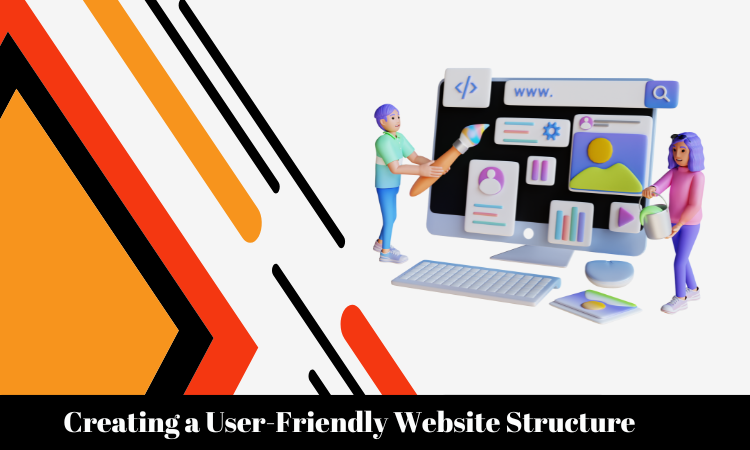
The user experience is a key factor in SEO success. In this section, we discuss the importance of a well-organized and user-friendly website structure. From intuitive navigation to mobile responsiveness, small businesses can learn how to create a website that not only satisfies users but also meets the criteria set by search engines.
Incorporating Advanced SEO Strategies:
Beyond the basics, small businesses can employ advanced SEO strategies to further boost their online presence. This section covers topics such as the importance of multimedia content, the role of backlinks, and the impact of social signals on search engine rankings.
Monitoring and Analyzing SEO Performance:

To refine and improve SEO strategies, constant monitoring and analysis are essential. This section introduces tools for tracking website performance, understanding user behavior, and making data-driven decisions to enhance SEO efforts.
Staying Updated with SEO Trends:
The digital landscape evolves rapidly, and SEO is no exception. Small businesses need to stay informed about the latest trends and algorithm updates. This final section provides insights into staying ahead of the curve and adapting SEO strategies to align with emerging trends.
Incorporating High-Quality Visual Content:
Visual content is a powerful tool for engaging audiences and enhancing user experience. In this section, we explore the impact of images, videos, infographics, and other visual elements on SEO. From optimizing image alt tags to choosing the right file formats, small businesses can learn how to integrate visually appealing content that not only captivates visitors but also aligns with search engine algorithms.
Building Internal and External Links:
Link-building remains a cornerstone of SEO, and in this section, we unravel the intricacies of building both internal and external links. From creating a solid internal linking structure for improved navigation to earning high-quality backlinks from reputable sources, small businesses can implement strategies to strengthen their website’s authority and credibility in the eyes of search engines.
Leveraging Social Media for SEO:

The symbiotic relationship between social media and SEO is often underestimated. This section explores how small businesses can leverage popular social media platforms to boost their SEO efforts. From optimizing social media profiles for search engines to creating shareable content that generates valuable backlinks, this section provides a roadmap for integrating social media seamlessly into your overall SEO strategy.
Monitoring and Analyzing SEO Performance:

Continuous improvement is at the heart of successful SEO strategies. Here, we discuss the importance of monitoring and analyzing SEO performance. From utilizing analytics tools to track key metrics such as organic traffic, bounce rate, and conversion rates, small businesses can gain valuable insights to refine their SEO strategies and ensure sustained growth.
Staying Updated with SEO Trends:
The digital landscape is dynamic, with search engine algorithms constantly evolving. In this section, we emphasize the significance of staying updated with the latest SEO trends. From core algorithm updates to emerging technologies like voice search and mobile optimization, small businesses can stay ahead of the curve by adapting their SEO strategies to align with current trends.
Conclusion:
Elevating a small business website through advanced SEO strategies requires a multifaceted approach. By incorporating high-quality visual content, building strong internal and external links, leveraging social media, monitoring performance, and staying abreast of SEO trends, small businesses can position themselves for success in the competitive digital landscape. As the online ecosystem continues to evolve, embracing these advanced strategies will not only enhance visibility but also establish a solid foundation for sustainable growth and increased brand recognition.
Q1: What is SEO-friendly content, and why is it important for small business websites?
A1: SEO-friendly content refers to web content that is optimized to rank well on search engine results pages (SERPs). For small businesses, this is crucial as it enhances online visibility, increases organic traffic, and helps attract potential customers who are actively searching for relevant products or services.
Q2: How can I identify the right keywords for my small business website?
A2: Conduct thorough keyword research using tools like Google Keyword Planner, SEMrush, or Ahrefs. Focus on keywords relevant to your business niche, products, or services. Consider long-tail keywords and assess their search volume and competition to make informed choices.
Q3: What are the key elements of crafting compelling and informative content?
A3: Compelling content is not only well-written but also addresses the needs and interests of your target audience. Use engaging headlines, provide valuable information, maintain readability, and include multimedia elements like images and videos. Strive for content that is both informative and enjoyable to consume.
Q4: How do I optimize meta tags and descriptions for better SEO?
A4: Craft concise and compelling meta titles and descriptions that accurately represent your content. Include relevant keywords naturally, making sure the meta tags align with the page content. Avoid duplication and ensure uniqueness across your website.
Q5: Why is a user-friendly website structure important for SEO?
A5: A user-friendly website structure enhances the overall user experience, which search engines prioritize. Ensure easy navigation, logical page hierarchy, and mobile responsiveness. A well-organized structure helps search engines index your content efficiently and improves the chances of higher rankings.
Q6: How can visual content contribute to SEO for small business websites?
A6: Visual content, including images, videos, and infographics, enhances user engagement and dwell time on your site. Optimize images with descriptive alt tags, captions, and file names. Engaging visuals can also attract backlinks and social shares, positively impacting your site’s SEO.



